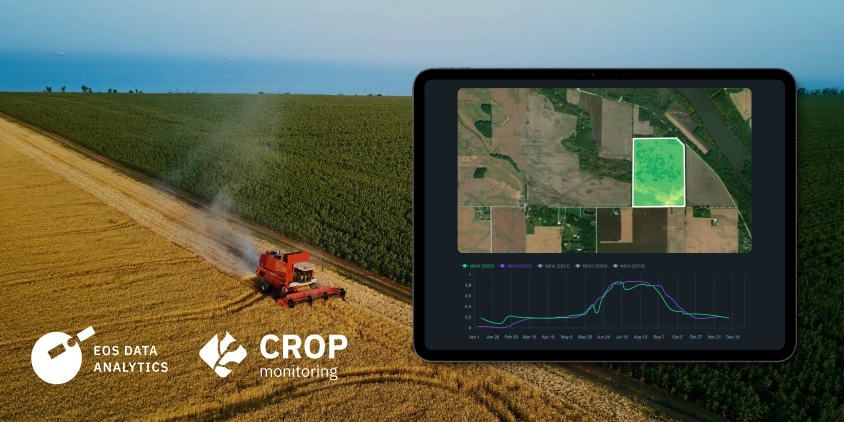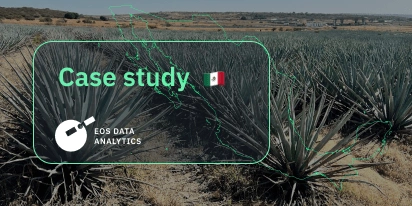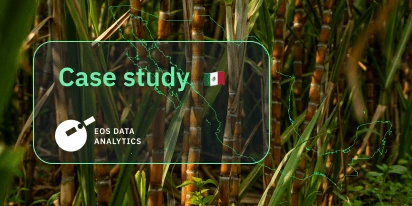
What Does Sattech Help Agribusinesses To Save Costs On?
Satellite technology is an irreplaceable tool in different industries. It provides worldwide communication and weather tracking and captures captivating images of the Earth. Companies like EOS Data Analytics, a global provider of AI-powered satellite imagery analytics, go one step further, processing the images and providing insights. Agriculture is among the industries that benefit from that.
Satellite imagery provides data on crop health, soil moisture levels, weather parameters, and other key variables. By analyzing this data, farmers can identify areas of their fields that require specific inputs such as fertilizers, pesticides, or irrigation. Precision farming allows for targeted application, minimizing waste and reducing input costs.
In this article, we uncover how exactly agribusinesses can save costs using sattech and dive into some real cases from our clients.
Fertilization And Irrigation
Input costs are a big part of the farm budget. Water management requires smart decisions, as this resource becomes scarce every year. That is why agribusinesses focus their attention on precision irrigation. This watering technique benefits from satellite imagery analytics, which allows the detection of crop moisture levels and helps ensure crops are irrigated just enough so they are not flooded or dried out. Agribusinesses can reduce irrigation costs and protect their crops from negligent practices.
One of EOSDA’s clients, The Morning Star Company, has faced similar challenges. In their former practices, the farmers working with the company tended to over-water the tomatoes that the company produced. As a result of that, the yield was dropping, as tomatoes became full of excessive water. They also developed a nutrient deficiency, so Morning Star needed to act fast.
The company created a Gradient project to work on the issue and determine how to ensure tomato health. As Gradient turned to EOSDA Crop Monitoring, a precision agriculture platform based on satellite imagery analytics, they discovered that using NDVI (Normalized Difference Vegetation Index), in combination with their ground sensors, can help determine the moisture content of the crops and pinpoint locations of the water deficiency. Sensors can show information in some limited areas, while satellites can cover much larger areas. Not only did Morning Star stop overwatering its farmers’ tomatoes, but it also decreased the irrigation costs by 10-15%.
Another prominent case was with Agroxchange Technology. The company’s goal was to establish a network of farmers in Nigeria and Ghana and then provide them with remote sensing tools to enhance and strengthen their farming practices. The digital data access in Sub-Saharan countries might not be so vast, so the farmers’ crops suffer from its absence.
Agroxchange aimed at small cotton farmers and gave them access to crop monitoring technology. The access to the platform allowed them to monitor the weather conditions on their farms, assess the crop health, and determine the soil moisture. All of that, combined with the comprehensive reports and timely notifications, helped Nigerian and Ghana farmers save on fertilization and irrigation costs.
We have many customers from different regions who apply remote sensing for irrigation management and input cost reductions. By optimizing resource management practices based on satellite data, agribusinesses can reduce water consumption, improve nutrient utilization, and lower operating costs.
Field Trip Expenses
Satellite imagery analytics in agriculture can serve as a base for field trip cost reduction. Remote sensing allows agribusinesses and farmers to detect pest infestations, diseases, etc. without visiting the field in question. By identifying these problems early, farmers can take timely action to mitigate damage and reduce the need for costly interventions such as extensive pesticide applications or crop replanting. For those farmers who have several hundred hectares, it is possible to monitor all their fields by visiting them. However, bigger market players can find it challenging to inspect all their fields effectively.
In this regard, EOSDA has an illustrative case study with the Agrinova Group. The company operates in Poland, Slovakia, and Ukraine, and there, it faced the challenge of meeting the new local regulations on fertilizer use. As mineral fertilizer effectiveness is typically around 40 to 60%, farmers and agribusinesses tend to overuse it to ensure its success.
Before, the company’s employees had many expenses related to constant field trips to evaluate the application use manually. Agrinova decided to work with EOSDA Crop Monitoring to check its fields and identify which areas require more or less fertilizer application. For that, it used the vegetation indices, combined them with the Variable rate application (VRA) maps, and generated productivity-based maps for various fields. Optimizing the mineral fertilization application helped the company increase yields and crop health. Additionally, Agrinova Group lessened the time and cost spent on field trips by 80%.
A similar case was with the Complete Farmer, a Ghanaian digital farming platform that serves local growers. The farmers needed to meet the international cultivation standards, but they lacked the data needed to confirm their practices. Complete Farmer used EOSDA Crop Monitoring’s functions, such as vegetation indices, weather forecasts and historical data, daily temperatures, and others. Farmers could now try out new fertilizers to address cultivation requirements, and the company did not have to visit every single field to check the effectiveness indicators. It resulted in receiving 90% of agronomic data through remote sensing and saving 40% of the field trips’ cost.
However, what matters the most is the human factor. People are the ones who make the final decision, and scouts play a crucial role in determining whether the specific spot experiences pests, disease hazards, and other crop health issues. With maximum accuracy, the identification of different risks can be carried out by humans, but thanks to satellite data, it is possible to help a person identify problem areas and point them out directly, saving a significant amount of time and money.
Operations And Technologies
Using diverse tech in farming is a common practice at this point. As the utilization of machinery is far more widespread than the use of software services, there are still companies that adopt precision farming software and, as a result, significantly cut operational costs. Some even manage to save on using hardware, as they can reduce oil and gas consumption and sometimes ditch the tool altogether if it is proven to be ineffective.
HIT Group, a Portugal-based tomato producer, faced the challenge of lacking visibility over the field conditions. This prevented the company from responding to crop health issues promptly. The producer’s specialists randomly inspected fields, going to the selected plots instead of going to the places that needed the inspection.
Such an approach hindered them from obtaining a full picture of the crop damage caused by natural disasters. Early detection of droughts, floods, and low temperatures would allow them to take action before significant crop harm is done. HIT Group used EOSDA Crop Monitoring to identify the specific problem fields or spots and only scout areas that required it. The company cut operational costs and saved personnel time and resources needed for field inspections, including vehicle use and gas spending.
Another prominent case of cost-saving on hardware happened in the Philippines. Agright Tech and Dole Asia faced the banana fungi disease devouring their crops. As fields were located in hard-to-get places, both companies tried to use drones to ensure they could cover every plot. However, locations were also elevated, and the height difference required constant drone adjustments. After a successful fly-out, thousands of drone photos needed to be stitched together to create a comprehensive picture that only displayed a natural view.
Since the whole process was complicated and limiting, Agright turned to EOSDA Crop Monitoring to receive sattech insights into banana health. It used different indices, including ReCl (Red-edge Chlorophyll Index), to assess the banana plots’ health from the office. Both companies managed to save up to 50% on drone usage costs.
As those companies prove that satellite imagery analytics can save operational and tech costs locally, the worldwide trends prove that they are on the crest of a wave rather than renegades. Autonomous tech is predicted to revolve around sattech as a way of calculating routes and providing general navigation. Tractors and harvesters can save fuel consumption costs and simultaneously reduce CO2 emissions due to their work . Thus, automation and software services will be a constant in the future of agriculture. The mechanization and control system markets are predicted to grow by 10.55% year-over-year up to 2030. These and many other insights you can find in EOSDA’s newest white paper on agricultural and agritech trends for 2024-2030.
Get the white paper
Field Inventory And Analysis
Satellite imagery analytics also reduces crop growth costs. For every ton of grown crop, the agronomist and farmer need to complete many activities and use several tools. They include input, machinery maintenance and repairs, labor, and some indirect costs. All of those account for field inventory costs and add to the final price the farmer or agribusiness puts on the crop tag. Many companies work on reducing those costs and making sure the produce does not suffer from it.
Global Textile in Uzbekistan had similar issues with its cotton-growing process. The company required regular field inventory and monitoring of more than 12,000 hectares of their land. However, analyzing plant emergence and determining the seed germination percentage was labor-intensive and time-consuming. There were also other costs related to the frequent field trips. Even experienced personnel found it difficult to conduct an accurate analysis of a field larger than 20 hectares, especially when these fields had irregular shapes. With the remote sensing data, each plot could be analyzed with an accuracy of up to one meter. Now, it takes 10–15 minutes to study data on the platform, not a full working day, for a Global Textile agronomist to analyze a 100-hectare field. The company managed to reduce the crop growing costs by 10-15%, including a cotton yield increase.
In this case, sattech data solved the problem of the huge time overhead needed for inspections and allowed Global Textile’s specialists to focus on other tasks for more efficient operations of the organization.
Insurance Claim Processing
Insurance companies that work with the agricultural sector have a need for effective field monitoring. In order to address the client’s claims, they inspect the field. Here, manual inspection rarely leads to a productive work day. Satellite imagery can provide objective evidence of crop conditions and damage extent, facilitating faster and more efficient claims processing. By streamlining all processes, insurers can reduce administrative spending and minimize the risk of fraudulent claims, ultimately lowering insurance costs.
Der Neue Horizont Re, S.A., a reinsurer of agricultural risks, was challenged by spending too much time and resources processing and validating insurance claims. The company used EOSDA Crop Monitoring’s scouting and historical weather data features to resolve the disputable issues faster when insurance claims were filed.
FONCOSPA, an insurance fund, required solid evidence about the multiple insurance claims connected to climate change its clients made. Using vegetation indices and combining them with Scouting reports, the company received a satisfactory amount of evidence to evaluate claims. FANCAMPO, an insurance entity, needed to streamline and automate its processes, and have access to the data on the client fields. Using EOSDA Crop Monitoring features like Season Analytics, Field Leaderboard, and Scout Tasks, the company managed to achieve remarkable results.
FANCAMPO now provides the highest level of precision in its insurance service, has improved the processing time of claims, and spends 30-35% less time identifying accident areas.
All of these clients are located in Mexico, but EOSDA also has customers in other regions. Insurance companies can use this data to assess the risk of crop losses more accurately and adjust their underwriting practices accordingly. By incorporating remote sensing data into risk assessment models, insurers can better quantify and price risk, leading to more accurate premium calculations and reduced overall costs.
Precision Farming
Precision farming is a practice that some farmers might consider to be too expensive. They have been doing conventional practices for years, so why change them now? Well, the answer is simple — it actually helps to save costs. For instance, to calculate how much a farmer or agribusiness spends, we need to add the costs of land management to unearned income. In Ukraine, this number is about $2,500 per hectare. This is how much a farmer loses on a hectare of their land in case of crop failure. Then, we have about 2-3%, let’s say, 20–30 ha, of failing fields that have some or another issue on them. That would account for $50,000–75,000 in lost costs on those hectares every season. Precision farming allows for avoiding those losses, as it minimizes deviations from optimal technological parameters and promptly detects and signals errors or existing risks.
Agrain, a Ukrainian modern-tech integrator, took it upon itself to introduce Ukrainian agribusinesses to precision farming technologies. Since the country is experiencing challenges of war in the agriculture sector due to war, its food producers find it hard to turn to new tech cost-effectively. However, platforms like EOSDA Crop Monitoring can cover the whole farm costs at a fraction of the losses they take.
Agrain provided the platform’s services to a selection of agrarians who managed to identify the spread of pests in their fields early. In those and multiple other cases, the company showed that precision farming is affordable. Agrain is now considering the widest range of factors in each individual case to make sure the precision farming practices are personalized and affordable for Ukrainian agribusinesses.
Precision farming is an emerging trend worldwide. As farmers face more challenges with climate change issues, they require more effective and accurate practices to ensure crop survival. This is not only about saving costs anymore but also about feeding the constantly growing population. To learn more about the agritech trend for this decade, download our white paper.
Get the white paper
Field Capacity Increase
Farming is a complicated endeavor, and in developing countries like Burundi, it needs to be supported by various international programs. The Belgian Development Agency, Enabel, was on its mission to increase yields of local farmers, as they suffered from unstable productivity and lacked data to operate on.
Enabel was able to improve farmers’ access to financial resources and encourage the adoption of modern technologies, such as satellite crop monitoring, with the help of EOSDA Crop Monitoring data, for better productivity and yield increase. The adoption of the technology helped farmers to improve field capacity, amplifying the value added from agricultural production and expanding family-level income-generating opportunities, all while diligently protecting and sustaining the region’s precious natural and environmental resources.
Satellites can capture data on crop growth and development throughout the growing season. By analyzing this data, agribusinesses can predict yield outcomes more accurately, allowing for better production planning, inventory management, and marketing strategies. This helps minimize the risks and optimizes revenue generation.
Bottom Line: Sattech Will Remain On The Rise
Let us look into the future for a moment. As climate change tirelessly marches the Earth, impacting every industry, agriculture suffers from it. Declining yields, decreasing arable lands, and spreading diseases are the tip of the iceberg of consequences that humanity will face in the near future. However, for agriculture and a number of other industries, there is hope, as satellite imagery analytics can provide all the tools for them to face the challenges and overcome them.
Satellite technology empowers agribusinesses with valuable data and insights that enable more informed decision-making, improved operational efficiency, and cost savings across various aspects of agricultural production and management. In our present time, changes are happening faster than ever, especially with climate change associated with more frequent and severe weather events, which include droughts, floods, and storms, which can adversely affect crop yields. Staying up-to-date and making data-driven decisions is crucial in our rapidly changing world. The success stories of our clients highlight the transformative power of wise data usage. Join the ranks of successful agribusinesses and farmers by leveraging EOSDA’s solutions to thrive in your operations and overcome the challenges of modern agriculture.
About the author:
Kseniia Kunakh has over 6 years of writing experience, working in various domains, including business, educational, and media-directed texts. Kseniia’s previous experiences as a development manager in a Ukrainian eco-NGO and as a talent matcher in an IT company make her a perfect combination of someone who is passionate about eco-tech innovations and can communicate about them with ease.
Recent articles

Digital Tools Improve Soil Health And Yields In Mexico
EOSDA and ITTA supported a Guanajuato farm with contour-line planning, monitoring tools, and practical guidance to reduce soil erosion and improve yields in the long run.

Analyze 2025 & Plan Your Best Year Yet: LandViewer Christmas Offer
It’s the most wonderful time of the year! The Christmas holidays are here, and so is your chance to analyze 2025 and plan a prosperous 2026 with more affordable Pro plans in LandViewer.

EOSDA Models Climate Change Impact On Sugarcane Yields
EOSDA modeled future temperature, rainfall, and other climate impacts on Veracruz sugarcane. The results help growers plan long-term adaptation strategies, including timing, varieties, and irrigation.